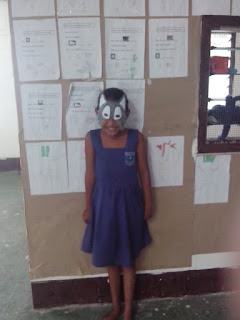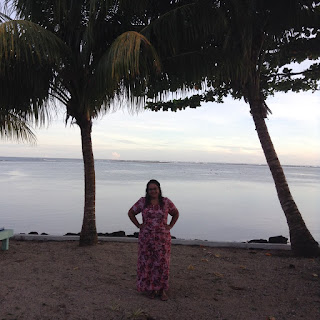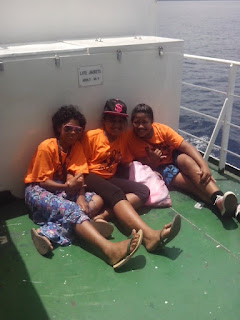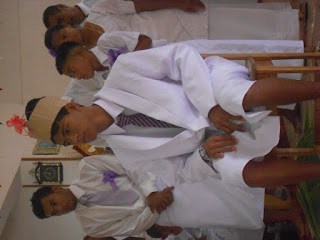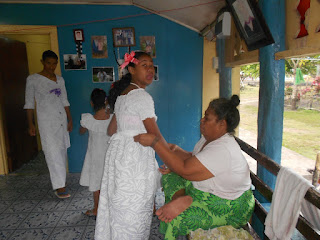“I’m going to town tomorrow.” This statement means something
different for every volunteer. For some volunteers who live near Apia, it means
they’re hopping on one of the many busses in their area. In about thirty minutes,
they’ll be in the Peace Corps office with Air Conditioning and computers with
internet. They will probably leave and head home in the evening. Volunteers who
live further away on Upolu might have to wake up earlier, walk further to the
nearest bus, and leave town a couple hours earlier. For those of us on Savaii,
it’s a little more of a process. For those of us further from the wharf on
Savaii, it means taking a long bus trip to the wharf, a long ferry ride, and
yet another bus. This is easier said than done. There are about seven of us who
live an hour or more out from the wharf, and my trip is convenient compared to
some people.
Here is what a typical trip is like for me:
Part one: Getting to the wharf on Savai’i
I have about 6 or 7 opportunities to catch a bus to the
wharf if the buses are running regularly. Some volunteers have more, a few have
less. I typically choose to leave at 6:30 because it isn’t crowded, and I’m
waiting for the bus right as the sun comes up. I cross the street and wait
under a street light (so my family can watch me and know I’m safe) 30 minutes
before the bus is supposed to come, because you never know if it will show up
early.
 |
| Here comes my bus |
If I miss the 6:30,
the next bus is usually pretty crowded, and I mean CROWDED. Every person
sitting has another person in their lap. People are squeezed as tightly as they
can be in the aisles, and the spaces under the seats are filled with suitcases
and woven baskets full of taro and roasted pig. The people on my bus are
awesome, because they always try to make space for Peace Corps volunteers to
sit. Any time I offer my seat to someone in the front of the bus, another seat
will magically materialize for me in the back. Sometimes I have to hold a child
or teenager in my lap, but it could be worse. Along the drive we stop a few
times at different stores, and the young men will run out to do the shopping
for the passengers as quickly as possible.
 |
| Wasn't joking about the baskets full of pig |
*I typically spend
the night in a hotel once I’m in Apia, but if I want to save money and take a day
trip, it means taking a bus at 2:30 in the morning so I can catch the 6am
ferry. I take the bus for about 30 minutes in the opposite direction of where I
need to go because once it loops back to my village, it’ll be too crowded to
get a seat and I might find myself sitting on an old woman’s lap!
 |
| This wooden bus is decorated with a Last Supper towel |
It usually takes
about an hour and a half to get to the wharf.
Part two: From island to island
If I catch the early bus, I might be able to just make the
8:00am ferry (if I hustle, and if it’s actually running). If not, I wait two
hours for the next one. The 8:00am is a smaller boat. Sometimes, there will be
wooden benches on the bottom level, and they are really nice on a sunny day.
But I once took that boat a few days before a cyclone, and I would have stayed
dryer if I swam to Upolu. The other small boat has no seats, but there are
wooden crates that hold life vests you can sit on. The big boat has plenty of
room to sit, and indoor areas, so it is definitely more convenient. The big
ferry also takes about an hour to reach Upolu, while the small ferries can take
twice as long.
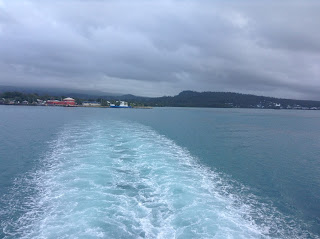 |
| Goodbye rainy Savai'i |
Part three: Nearly there
 |
| Where you sit (or sleep) on the small ferry |
As the boat is docking, everybody rushes and squeezes
together near the doors for the mad rush to the buses. Again, you need to
hustle to get a seat. There are usually fewer buses at the wharf on Upolu than
there are on my island, but people on this island are much less likely to make
a seat for me just because I’m white, so there is a good chance I will be
standing in the aisle. The bus drivers on this route love to blast the music as
loud as they can, and someone always smells like fried chicken, so I’m usually
pretty happy when we finally make it into Apia after an hour. We all get off
the bus and I either catch a cab or take a long walk to the Peace Corps office,
where I crash in the nearest room with air conditioning!
Part four: Homeward bound
 |
| Colorful wooden buses are always coming and going |
When it’s time to go home, I usually plan to take the last
ferry at 4:00pm. That means saying goodbye to everyone as early as 1:15 to rush
off to the bus depot. The bus can leave anytime between 1:30 and 2:30. It can
be delightfully empty, but typically, it’s horribly crowded. After the hour
long trip, I usually get to the wharf with about an hour to wait for the ferry.
It’s best when I have other volunteers to wait with.
 |
| With Robert on another small ferry |
The last boat is always
the fast, large one, so I’m guaranteed a seat and a crowd. Fifteen minutes
before the boat docks, we all squeeze on to the steps leading to the door. As
soon as we can, we rush to the many, many crowded buses to try and get a seat.
 |
| Who will be the first out the door? |
There usually isn’t enough time to say goodbye to other volunteers, so we wave
to each other out the windows of our different buses, and head in different
directions. After an hour and a half, many stops at different stores, lots of
rearranging of the seating arrangement, and plenty of absolutely stunning
scenery, I finally make it to my village. I get off the bus and walk pass my
family’s house where the children run up and ask, “manaia le malaga?” Did you
have a nice trip?
 |
| Bye! I hope whoever sits on your lap took a shower today! |
Time in transit: 10 hours (if I’m lucky)
Total cost: $44
Sure, it was a nice trip.





